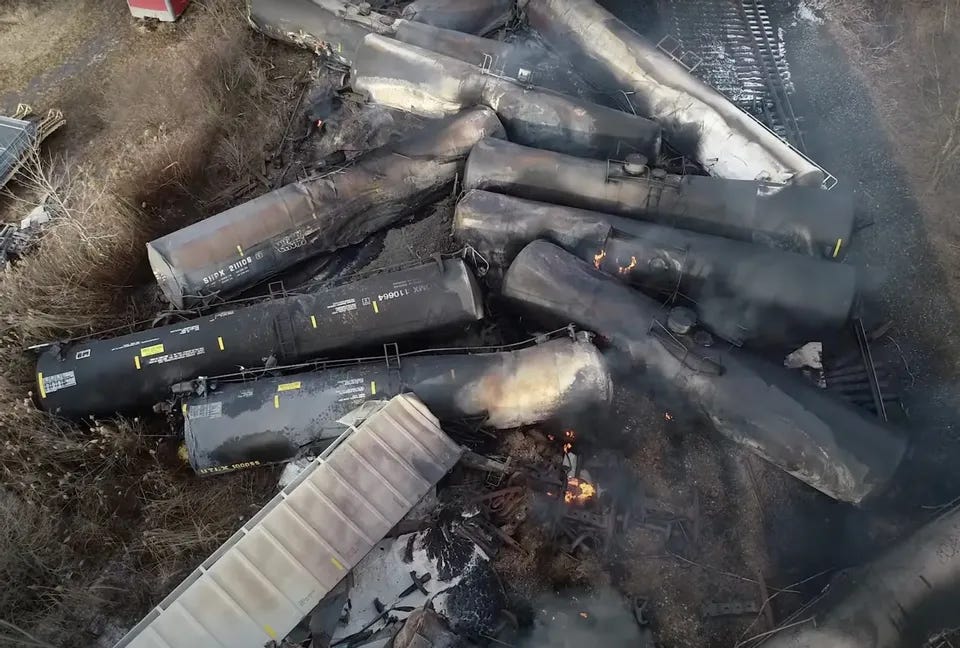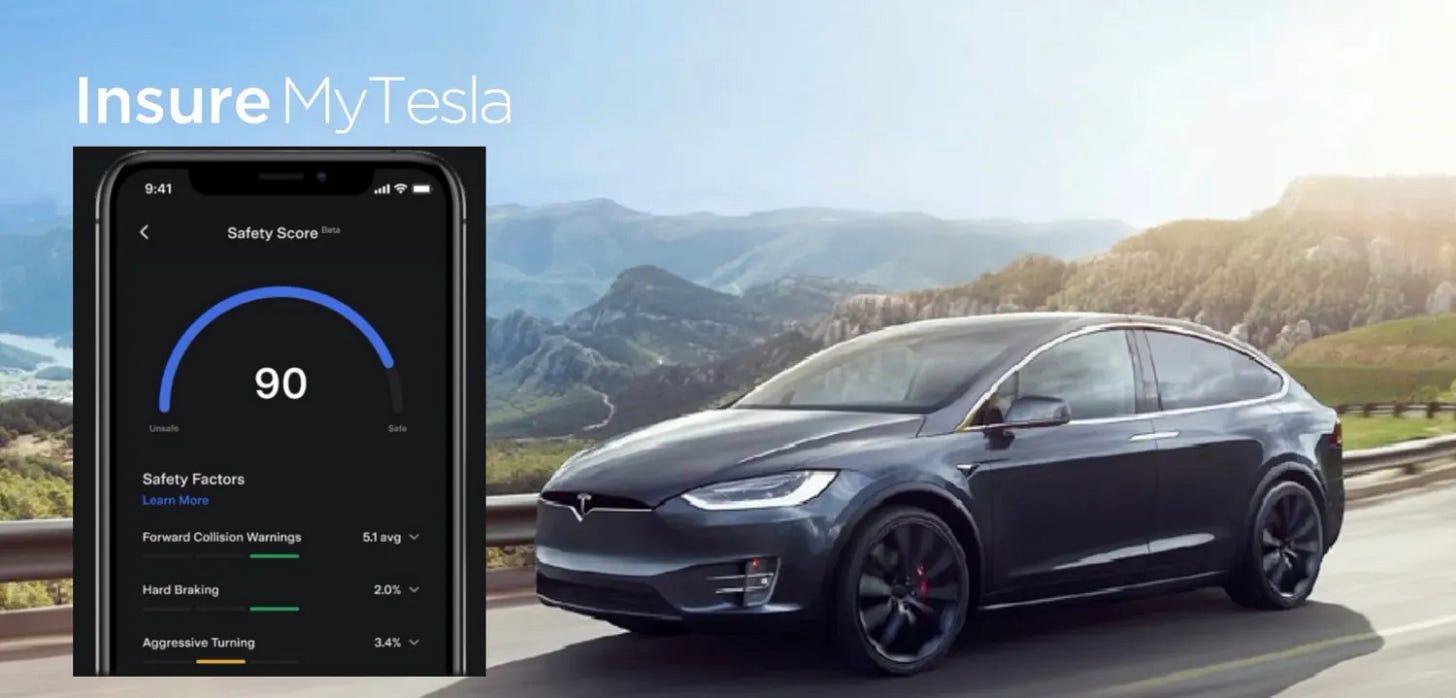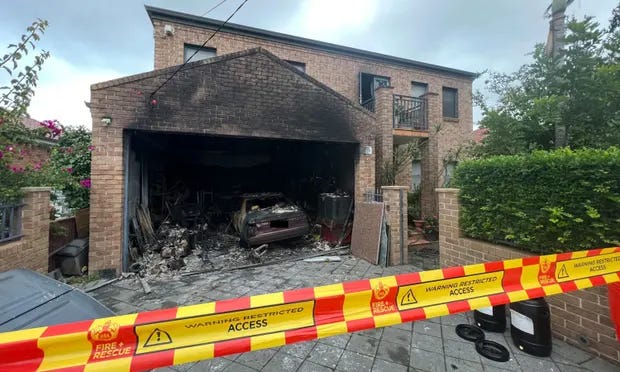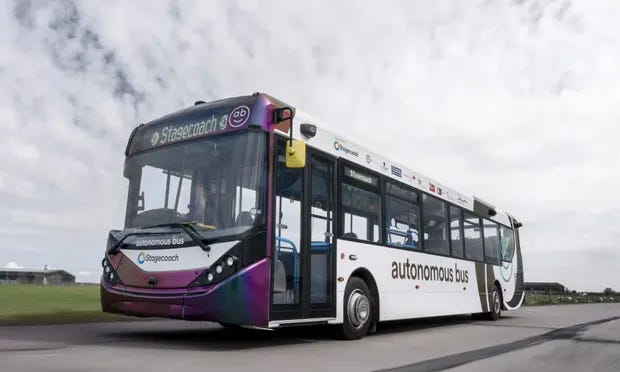(De)Rail Mania
This edition takes a deeper dive into the US freight rail system issues, looking especially at the interplay between efficiency initiatives and rail accidents
First things first, Happy Easter everyone!
Derailments keep coming in the US. Since the Norfolk Southern derailment in East Palestine, OH on February 3rd which made headlines for the vinyl chloride leak, subsequent burn-off and evacuation of residents, there’ve been at least six other accidents in the span of sixty days. Most recently, on March 30th, 22 cars of a BNSF train carrying ethanol and corn syrup derailed in Raymond, Minnesota. The contents spilled and are being burnt off .On March 29th 25 cars of a Union Pacific train derailed in Port Allen, Louisiana. On March 26th, 31 cars of a Canadian Pacific train carrying liquid asphalt and ethylene glycol derailed in Wyndmere, North Dakota followed by one in San Bernardino, California just a few hours later. You get the picture

At the US Senate Committee on Commerce, Science, and Transportation hearing, the National Transportation Safety Board (NTSB) chair Jennifer Homendy said "This derailment [East Palestine], as all accidents we investigate, was 100% preventable [emphasis added]" (Source).
"This derailment [East Palestine], as all accidents we investigate, was 100% preventable" (NTSB chair Jennifer Homendy)
If all derailments are so preventable, why do they keep happening? How significant is this problem for supply chains? What is being done to address this issue?
Three Derailments per Day
Derailments in the US are extremely frequent, albeit most have relatively minor consequences. The East Palestine derailment was certainly a supply chain, social and environmental disaster but it’s worth noting that such catastrophic accidents don’t happen regularly. A similar incident took place close to 10 years ago, in Casselton, North Dakota. However, in 2022, 1,164 derailments took place. That’s 97 per month or 3 PER DAY. The only thing you should be surprised of is that derailments aren’t always on the morning, noon and evening news. Believe it or not, the 1,087 number is actually an improvement compared to previous years. Between 2000 and 2021, trains derailed on average 1,674 times per year. Here I was thinking that rail is a relatively safe transport mode.

How does the US fare against other countries? For the amount of freight moved yearly, not so bad. For the speed at which freight is transported, abysmally. Germany had the most derailments of European countries having experienced 300 rail accidents in 2019. Poland was second with roughly 200. These figures are 3-5 times lower than the US. However, these figures ignore the size and freight task of the US. The US freight rail network is 144,000 kilometres, about 4 times larger than Germany’s (33,000) and 8 times larger than Poland’s (18,500). US rail freight task is also enormous by comparison – 2.53 trillion tonne-km versus Germany’s 123 billion tonne-km or Poland’s 121 million tonne-km. Yes, that’s several orders of magnitude larger than the European contenders. Here’s the kicker. German freight trains travel at speeds up to 160 kph (99 mph) for lighter trains and 120 kph (75 mph) for heavy freight trains. US freight trains travel on average at 40 kph (25 mph).
German freight trains travel at speeds up to 160 kph (99 mph) for lighter trains and 120 kph (75 mph) for heavy freight trains. US freight trains travel, on average, at 40 kph (25 mph).
The network speed differences reveal just how significant the derailment problem is in the US. It’s not just that German freight trains can travel 3 to 4 times faster than US freight trains. It is the amount of coordination to make that happen in a safe manner at 3 or 4 times the speed. Intervals between trains must be increased significantly to account for longer stopping distances, access to rail segments must be managed much. Moreover, few (if any) accidents in Germany have ever generated consequences as disastrous as East Palestine.
Derailment Factors
Why do derailments keep happening? The easy answer is human error, rolling stock, infrastructure and environmental factors. In reality, there are factors and enablers which are interconnected. Excluding sabotage or intentional vandalism, the Federal Railroad Administration (FRA) analyses four main reasons for derailments:
Human error - errors made by train crew members, such as improper braking or speeding, can lead to derailments. The FRA estimates human and train management factors accounted for 24% of train accidents in 2020.
Rolling stock - malfunctions or failures of equipment such as wheels, brakes, couplers, or locomotives can lead to a derailment. The FRA safety statistics indicate that equipment failure accounted for 27% of train accidents.
Rail infrastructure – defects in the track, such as broken rails, defective switches, and inadequate maintenance, can cause derailments. Infrastructure-related defects accounted for nearly 34% of all train accidents in 2020.
Environmental factors - extreme weather conditions (heavy rain, snow, or high winds) can affect the track or equipment and lead to derailments as can level rail crossing collisions.
Latent Derailment Causes
Although the ultimate cause of derailments and accidents will likely fit into one of the four categories (human error, rolling stock, infrastructure, environment), it is important to realise that these categories only help assign blame not identify actionable causes.

Freight rail companies in the US have, for more than half a century now, reduced their labour intensity. In 1952, railways employed 1.3 million people. Currently, they employ around 150,000 people. Over the past four years alone, railways have reduced their workforce by 40,000 workers. These workforce reductions were enabled by efficiency initiatives and innovations such as precision scheduled railroading (PSR), reductions in the minimum number of train crews or, longer trains. While these initiatives themselves do not directly lead to derailments, they can contribute to their frequency or severity.
Precision scheduled railroading (PSR) is a particularly interesting example of initiative which Rail Workers United (RWU), an inter-union caucus, argued contributes to derailments. PSR is a scheduling method which focuses on individual cars, rather than trains. Prior to PSR, unit trains (carrying one type of cargo) would need to reach a certain length to depart. Under PSR, mixed freight trains (carrying multiple types of cargoes) are frequent and schedules are generally tighter to enhance schedule predictability. This has allowed railroads to reduce labour inputs but seems to have also compressed railcar inspection times. A rail worker summarised this by saying “You used to have guys walking each side of a train, taking 2-3 minutes for each car. And now they’re pushing for 90 seconds to inspect a car. There’s a lot that can be missed" (Source). Moreover, prior to PSR, the train composition favoured heavy cars first, while that is not currently always the case. RWU argued that this particular issue increased the severity of the East Palestine crash as heavy cars collided with lighter ones and “jackknifed the cars into the air”.
Precision scheduled railroading isn’t the reason trains derail, it is an example of initiatives that are likely to increase the risk or severity of accidents over time. The less time available for inspections, the more likely preventable rolling stock issues are missed. The statistical cause of the derailment will surely be a “rolling stock issue”, but this won’t paint the picture of why the accident happened in the first place. The smaller the train or dispatch crew, the more system redundancy is diminished. When an accident does happen, it will surely be a “human error” and will support the argument that humans are unreliable, error beings while ignoring how excessive workloads may lead any system (human or digital) to failure. Train compositions agnostic to car weight may enhance handling efficiency as they reduce shunt moves but may also increase accident severity. Unfortunately, despite the actual or potential consequences of efficiency improvement initiatives, it is unlikely that the situation will change.
Addressing Derailments
I started writing this post thinking it would be mostly about US rail infrastructure underfunding leading to its increasingly concerning rail safety record. The poor state of the rail infrastructure certainly plays a role given that a third of accidents have infrastructure issues as a main factor. However, it became increasingly obvious that neither one of the factors (human error, rolling stock, infrastructure or the environment) are in fact actionable causes. Broken rails cause accidents, but why did the rail break? Wheel bearings overheat, as was the case in the East Palestine accident. Does this mean that East Palestine was caused by equipment failure? If so, how does knowing this help in addressing future accidents?
Interestingly, it seems that initiatives that aimed to improve operational efficiency (often leading to layoffs) can increase the probability or severity of accidents. PSR was one example. Positive train control (PTC) technology is another such potential example. PTC is an advanced train control system that uses GPS and other data to monitor and control train movements automatically. PTC can improve safety and reduce the need for manual interventions, which could help reduce the workload for train crews, including train drivers (according to ChatGPT). Ostensibly, PTC is a safety initiative. However, what is the most frequent consequence of automation and reducing workloads? Reducing the workforce. The title changes, the story stays virtually the same. Don’t get me wrong, this technology has the potential to enhance rail safety and security. As many technologies before it however, its potential may be misjudged and workforces reduced before the technology is proven.

Apart from investments in track maintenance to ensure that rail infrastructure doesn’t look like in the video below, the potential consequences of efficiency initiatives and innovations on safety risks over the short- and long-term should be assessed prior and following their implementation. Most organisations are trying to assert their credentials beyond just financial gain (see Norfolk Southern’s ESG report or Union Pacific’s Climate Action Plan). Yet, ultimately, it seems that as Prof. Jeffery Pfeffer put it “money trumps all”. It is challenging, to say the least, to imagine how statements on reducing environmental impact and emissions are compatible with initiatives which reduce costs but may contribute to worsening the impacts social, economic and environmental impacts of rail accidents.
Thanks for reading interconnected so far! If you haven’t already, subscribe below. Not only you’ll get regular updates straight to your email but you’ll also be supporting my work!
Share this post if you’ve found this interesting
In Other News
Tesla’s Safety Score

I covered last week Vaclav Smil’s article about overhyped innovations and linked it to connected vehicles and how they’re not necessarily delivering on all the benefits promised to consumers, giving the example of Ford’s self-repossessing vehicle.
It’s Tesla’s turn to illustrate the same point with their Safety Score Beta. Tesla’s Safety Score monitors your driving behaviour to determine the premium you need to pay for the Tesla Insurance. In other words, the car manufacturer punishes behaviour it doesn’t want and rewards behaviours that it wants to see in its drivers. With the latest update, night driving is a no-no, as this Twitter user highlights. The vehicle you paid for isn’t really yours anymore.
Shoshana Zuboff argued this very point in her book ‘The Age of Surveillance Capitalism’. The difference between a stark warning verging on conspiracy theory and lived experience…about 6 years.


The Case of The Exploding Battery

An e-bike Li-ion battery explosion and subsequent fire in a Sydney home damaged a home and destroyed a car. E-bike batteries are generally small, but they pack a punch if they start burning. I can understand why sailors may be concerned about transporting electric vehicles and batteries. I’m a fan of electric bikes but I’m a bigger fan of continuing to have a roof over my head.
Driverless Busses Creating Jobs
A world first, groundbreaking news, Scotland is introducing six driverless busses from the 15th of May carrying passengers between Ferrytoll park and ride in Fife and the Edinburgh Park train and tram interchange just outside Edinburgh. The bus will be operated by TWO members of staff: one, in the drivers seat, monitoring the bus operation and another selling tickets and helping passengers.
This is truly groundbreaking news, automation is creating MORE JOBS!
I’ve written in the past about “Who fixes the tyre on an autonomous truck” to highlight that drivers don’t only drive but perform a multitude of tasks which may cost more to automate than just sticking with the human. Imagine that the bus does end up being driverless but requires a human bus captain to sell tickets. What exactly was achieved? The bus cost triples and the labor cost stays roughly the same…
Next Station on the Technology Hype Train: Denial

PwC recently released the “2023 Digital Trends in Supply Chain Survey” which revealed that 83% of the 300 or so executives surveyed have NOT seen their supply chain technology investments have not fully delivered expected results. This is despite the fact that 84% of respondents have either partially or fully adopted cloud technologies, and 79% have implemented IoT. McKinsey claimed in 2019 that 70% of digital transformations fail so things haven’t changed much in the last years.
Beyond the fact that there’s limited understanding or research into why the failure rate is so unbelievably high, the reaction to the high failure rate of technology implementation is even more astonishing:
“In spite of lack of satisfaction with current tech implementations, companies are still forging ahead with future ones. Looking ahead, the technologies that will be seeing the most investment in the future are artificial intelligence and machine learning. Twenty-two percent of respondents said their companies plan to invest at least $5 million in those technologies in the next two years.” (Source)
Do facts matter?




